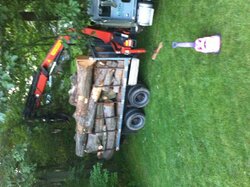We've now had enough oil bills this season for me to take a first run at quantifying the effect of our new wood burning fireplace insert (Fireplace Xtrordinair 33 Elite).
During the coldest part of last winter (2012-2013), from December 4 to March 4, we used approximately 456 gallons of oil. During the same period, there were about 3072 heating degree days. So, we got about 6.73 heating degree days per gallon. (I'm focusing on the coldest part of winter since we also use oil for our hot water, so the numbers for other parts of the year aren't directly comparable.) This was also with our thermostats kept relatively low, and after having some insulation work done in the fall of 2012. We have our little kids in the house all day, so significant energy usage is kind of inevitable.
This year, from November 19 through February 18, we used approximately 434 gallons of oil. During the same period, there were about 3485 heating degree days -- a colder winter. This means we got about 8.02 heating degree days per gallon.
Another way to look at it is that, if we had done this winter at the same rate of HDD per gallon as last winter, we would have used 518 gallons so far, as opposed to the 434 gallons we have used. At our latest heating oil prices, those 83 extra gallons would have cost $325.
While I'm happy that our oil bills are lower, the savings are not quite as big as I had been hoping. In fact, once you consider the price of the wood we've been burning, it's probably a wash at best. So, unless the numbers look dramatically different at the end of the heating season, it probably makes the most sense to think of our fireplace as something that enhances the ambiance, keeps the living room toasty, and prepares us for emergencies, rather than something that saves us money on a day-to-day basis.



